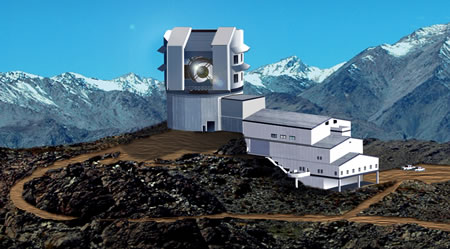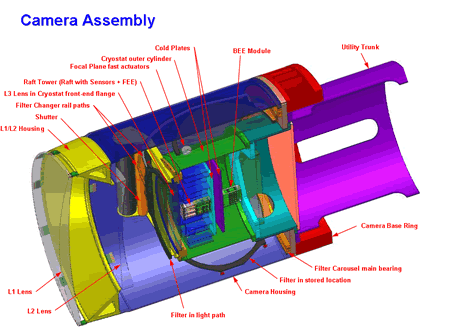Science Fiction
Dictionary
A B C D E F G H I J K L M N O P Q R S T U V W X Y Z
Use Google To Search The Heavens

Google has joined the Large Synoptic Survey Telescope (LSST) Project, which intends to complete the world's largest survey telescope by 2013. Google will work with nineteen universities and national labs that are designing and building the telescope.
The proposed telescope itself will be a ground-based 8.4 meter, 10-square-degree field instrument capable of providing digital imaging across the entire sky. In an endless series of ten-second exposures, the LSST will cover the available sky every three nights over a period of ten years. The telescope will be built atop Cerro Pachón in Chile.

(Large Scale Synoptic Survey Telescope site (planned))
The LSST camera is designed to provide a wide field of view - sampling more than 0.2 arcsecond; spectral sampling will be done in five or more bands from 400 nanometers (nm) to 1040 nm. The format for the image will be a circular mosaic providing more than 3 gigapixels per image. This is approximately 1,000 times the resolution of a typical digital camera photo.

(Large Scale Synoptic Survey Telescope diagram)
Google and LSST share some important characteristics; both groups seek to organize massive quantities of data and then share it in the most useful possible form. Every night that the LSST operates, it will store over thirty terabytes (30,000 gigabytes) of data. Google will provide assistance in the following areas:
- organizing the flow of large parallel data streams
- processing and analyzing the data streams in a continuous 24/7, fault-tolerant manner
- providing a dynamic view of the night sky for the lay public, as well as for specialists.
The LSST will help astrophysicists explore the mysteries of dark matter and dark energy, as well as providing a movie-like picture of objects that change rapidly - like exploding supernovae. The LSST will also help with discovering near-Earth asteroids (it should be able to resolve objects as small as 100 meters) as well as distant Kuiper Belt objects.
This project is not Google's first step into the sky. Google has already collaborated with NASA in its iEarth program.
Every day, NASA's Earth Observing System (EOS) transmits terabytes of data back to ground stations. The Google Earth application already provides easy access to worldwide maps. iEarth is an application that superimposes this data on top of 3D maps provided by Google Earth.
Picking a spot on the Earth will prompt the application to look through EOS and convert that data into a file viewable from Google Earth.
These two projects have an unusual precursor in science fiction. In Neal Stephenson's excellent 1992 novel Snow Crash, Hiro Protagonist is given an amazing service - ordinarily available only to the wealthy - for free.
There is something new: A globe about the size of a grapefruit, a perfectly detailed rendition of Planet Earth, hanging in space at arm's length in front of his eyes. Hiro has heard about this but never seen it. It is a piece of CIC software called, simply, Earth. It is the user interface that CIC uses to keep track of every bit of spatial information that it owns - all the maps, weather data, architectural plans, and satellite surveillance stuff.
(Read more about CIC Virtual Earth)
Even sf visionaries like Stephenson would have called a ten year-long movie of the entire observable universe too futuristic to be believable in a novel. Nevertheless, Google engineers will present the entire universe in the palm of your hand, just like Stephenson's Virtual Earth.
Read more about Google/NASA iEarth. Don't forget their obsession with the "inner space" of humanity's imagination; take a look at Encyclopedia Googlactica - Google To Put All Human Knowledge Online. Learn more about the survey telescope at LSST.org.
Scroll down for more stories in the same category. (Story submitted 1/8/2007)
Follow this kind of news @Technovelgy.| Email | RSS | Blog It | Stumble | del.icio.us | Digg | Reddit |
Would
you like to contribute a story tip?
It's easy:
Get the URL of the story, and the related sf author, and add
it here.
Comment/Join discussion ( 0 )
Related News Stories - (" Engineering ")
Replace The Smartphone With A Connected Edge Node For AI Inference
'Buy a Little Dingbat... electropen, wrist watch, pocketphone, pocket radio, billfold ... all in one.' - Raymond F. Jones, 1945.
Sunday Robotics 'Memo' Bot Has Unique Training Glove
'He then started hand movements of definite pattern...' - Robert Heinlein, 1942
Tornyol Microdrone Kills Mosquitoes
'The real border was defended by... a swarm of quasi-independent aerostats.'
PLATO Spacecraft, Hunter Of Habitable Planets, Now Ready
'I ... set my automatic astronomical instruments to searching for a habitable planet.' Edmond Hamilton (1936).
Technovelgy (that's tech-novel-gee!) is devoted to the creative science inventions and ideas of sf authors. Look for the Invention Category that interests you, the Glossary, the Invention Timeline, or see what's New.
Science Fiction
Timeline
1600-1899
1900-1939
1940's 1950's
1960's 1970's
1980's 1990's
2000's 2010's
Current News
Replace The Smartphone With A Connected Edge Node For AI Inference
'Buy a Little Dingbat... electropen, wrist watch, pocketphone, pocket radio, billfold ... all in one.'
Artificial Skin For Robots Is Coming Right Along
'... an elastic, tinted material that had all the feel and appearance of human flesh and epidermis.'
Robot Guard Dog On Duty
I might also be thinking of K-9 from Doctor Who.
Wearable Artificial Fabric Muscles
'It is remarkable that the long leverages of their machines are in most cases actuated by a sort of sham musculature...'
BrainBridge Concept Transplant Of Human Head Proposed
'Briquet’s head seemed to think that to find and attach a new body to her head was as easy as to fit and sew a new dress.'
Google's Nano Banana Pro Presents Handwritten Math Solutions
'...copy was turned out in a charming and entirely feminine handwriting.'
Edible Meat-Like Fungus Like Barbara Hambly's Slunch?
'It was almost unheard of for slunch to spread that fast...'
Sunday Robotics 'Memo' Bot Has Unique Training Glove
'He then started hand movements of definite pattern...'
Woman Marries Computer, Vonnegut's Dream Comes True
'Men are made of protoplasm... Lasts forever.'
Natural Gait With Prosthetic Connected To Nervous System
'The leg was to function, in a way, as a servo-mechanism operated by Larry’s brain...'
Spidery 'Walk Me' Toyota Autonomous Wheel Chair Like Star Wars
Walk along with the emperor.
Dancing Robots Taught Dance Moves
'A clockwork figure would be the thing for you...'
Proof Of Robothood - Not A Person
'Who are you people? - Show 'em.'
Indonesian Clans Battle
'The observation vehicle was of that peculiar variety used in conveying a large number of people across rough terrain.'
The 'Last Mile' In China Crowded With Delivery Robots
Yes, it's a delivery robot. On wheels.
Tornyol Microdrone Kills Mosquitoes
'The real border was defended by... a swarm of quasi-independent aerostats.'
